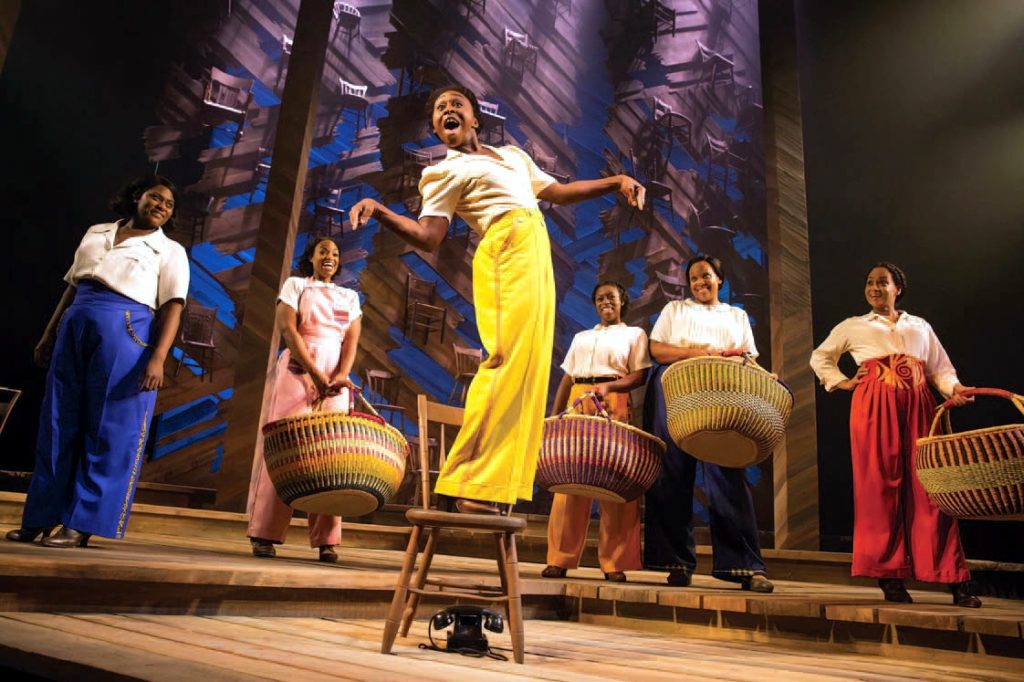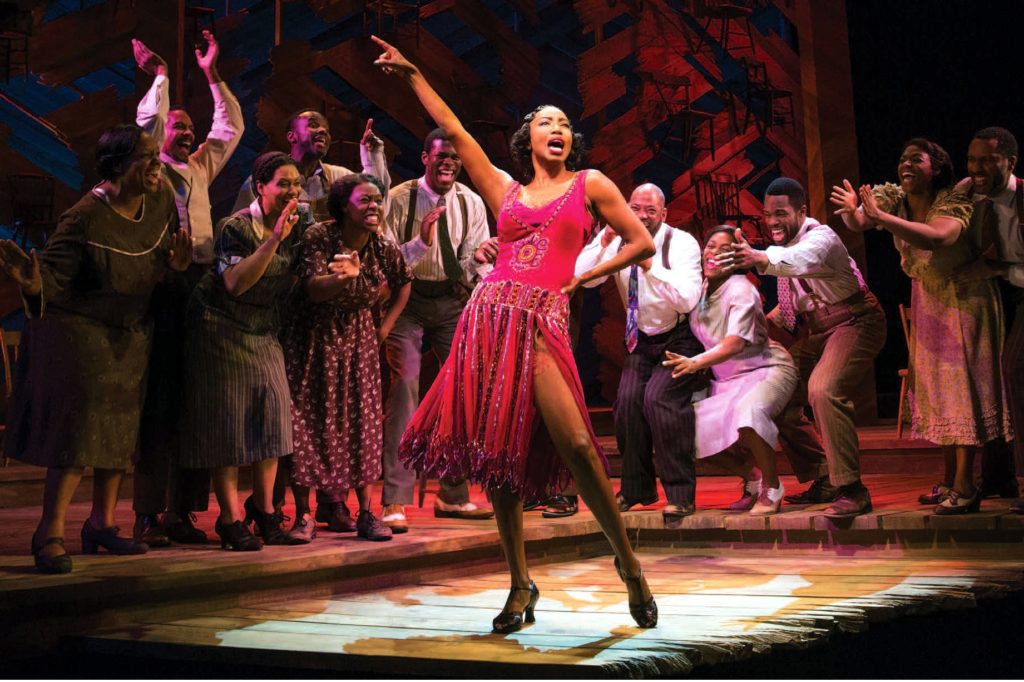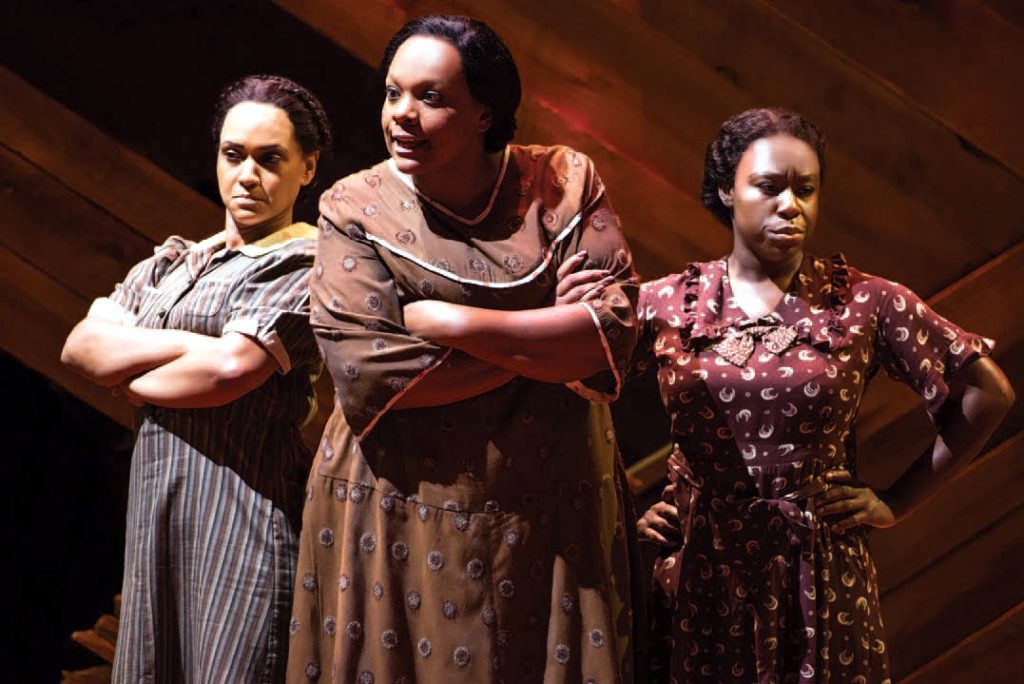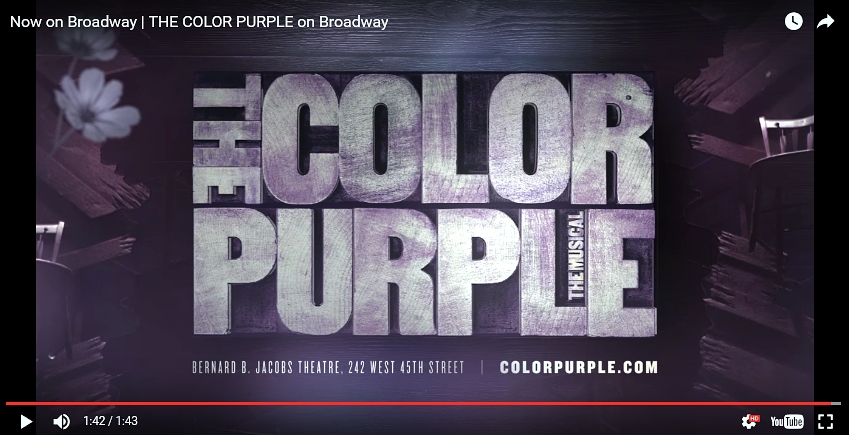
The Color Purple is not a comfortable read. Alice Walker’s Pulitzer prize-winning novel plunges us into the harsh world of the Jim Crow South in the early 20th century, seen through the eyes of a poor, uneducated black woman named Celie. Although ultimately redemptive, and even humorous at times, the story takes us through the horrors of nearly 40 years of rape, incest, sexism and violence – especially towards women – before Celie gradually learns that she, too, can love and be loved; a revelation that ultimately leads to her independence and salvation.
Some might say that adapting such a range of complex and difficult subjects into a Broadway musical format is a tall order and, if the critics are to be believed, the original 2005 production rather missed the mark, despite being a box-office success. However, once in the hands of the softly spoken, award-winning director, John Doyle, it was a different story. Literally . . .
Described as “one of the greatest revivals ever”, Doyle’s new, stripped-down Broadway production is finally garnering the rave reviews that were so noticeable by their absence the first time around. Doyle reduced the original two-and-a-half hour production to just two hours (with the blessing of the musical’s book writer, Marsha Norman) and greatly simplified the sets and costumes. The reworked, streamlined version enjoyed a first, enormously successful run at London’s Chocolate Factory in 2013 before being considered strong enough for a Broadway revival, which debuted at the Bernard B. Jacobs theatre on Broadway in December 2015.
On both occasions, Doyle called on the British, Tony award-winning sound designer Gregory Clarke to create a clean, powerful sound design that would accurately reflect both the passion and the pathos of Alice Walker’s tale of oppression and redemption. Told through a score that swings from jazz to blues and from ragtime to gospel, Clarke’s mission was to deliver crystalline audio quality that would suit Doyle’s “bare bones” aesthetic whilst ensuring that every member of the audience, regardless of where they were seated, enjoyed a first-rate audio experience. Clarke had no hesitation in specifying EM Acoustics for the vocal system, which he describes as a “simply obvious choice for me on this very special new production. The orchestrations, indeed the entire piece has been stripped back to the emotional and physical core. The show delivers its vocal and musical content with jaw-dropping simplicity and power. I knew that this would expose the audio to a huge degree, so I needed to specify a system that would handle that exposure.”
Clarke has used EM Acoustics loudspeakers on a variety of musicals over the past few years, and says that the systems have proven to be “the most elegant and flexible of tools.”
“EM caught my ear over a decade ago,” he continues. “They have a refreshing and very personal approach to loudspeaker design and their equipment continues to delight.”

Clarke chose to deploy EM boxes on the original London version of the show in 2013 and reports that they performed “spectacularly well.” Seeing no reason to change a successful formula, he therefore specified a complete EM Acoustics vocal system on the bid list for the Broadway version which was accepted without question by all the bidders concerned; a reaction seen by Clarke as proof positive of EM Acoustics’ growing reputation in the US. The contract was finally awarded to Masque Sound who, as a result, invested in a significant EM system for the show.
“Masque Sound were, as usual, absolutely brilliant to work with,” says Clarke. “Scott Kalata and the rest of the Masque team were helpful, constructive and just got it. The equipment was all delivered in great condition and working perfectly, whether it was new out of the box or not.”
A key element of Clarke’s sound design was the Halo-C line array which Clarke calls “truly outstanding,” despite his innate suspicion of line array systems in general. “I have never been a particular fan of line array systems. We all know the benefits of the form factor and the huge advantages in the scalability and flexibility of arrays. However, those advantages have tended to be obscured by some very, very dodgy physics at the design stage, resulting in an awful lot of systems that, were we to be entirely frank, sound pretty desperate.”
“Halo-C, on the other hand, has all the physical advantages in abundance but, critically, it sounds simply tremendous. The system is transparent, honest, interesting, involving and ridiculously powerful for its size.”
Not known for mincing his words, Clarke goes on to note with typical candour, “I am always deeply unnerved by the obscure proprietary software and radical processing inherent in some other systems. Halo-C just needs a touch of EQ, dependent on the number of boxes in the line, and it’s ready to go. That makes it a pleasure to work with and speaks of the genius that has gone in to designing the elements. It strikes me that the design process for Halo started with a deadly serious sonic ambition, and not with a desire to knock out yet another range of rather ghastly and largely expendable curvy speakers.”
The smaller boxes that make up the rest of the system on The Color Purple are, according to Clarke, no less critical than the array. There are 24 EMS-51 and 20 EMS-61 ultra-compact and compact passive loudspeakers handling delay, side-fill and front-fill, complemented by a handful of EMS-122s and EMS-81s. “In my opinion the 51s and 61s are simply the best small speakers on the face of the planet,” affirms Clarke.
“The consistency of the voicing between all the system elements is staggering; size notwithstanding, there is very little difference in overall personality, no matter what loudspeaker the audience is listening to. This is a major creative consideration for me and hugely beneficial to the overall design which is coherent, clear and, like the rest of the production, has no extraneous elements. I don’t like to include anything, at any point in the chain, which just shouldn’t be there. The aim is simply for every member of the audience to get the best possible account of the story at every level.”
When it came to console choice, Clarke was equally emphatic. “I think the DiGiCo SD7 is the best-sounding desk around, and the closest approach to an analogue sound in a digital world. The ‘T’ software is now really exceptional – the signal flow, workflow and usability of the interface are terrific. Strange as it may sound, I also like that the operator and designer can stand shoulder-toshoulder behind the desk, something that seems to have been overlooked in the development of high-end digital consoles. Sometimes smaller really is not better. If you can’t get behind the desk at the same time as the operator, workflow can be seriously hampered, and it’s just not fun trying to talk to a large-scale console on a laptop. The tactile relationship with the desk is still very important to me.”
For amplification and processing, Clarke opted for MC2 amplifiers to drive the EM Acoustics vocal system, and XTA processing. “The MC2 amps are just extraordinary, as is the XTA kit I used for processing in this instance,” he says. “The XTA stuff still sounds just great, and we ran the entire system at 96kHz. The benefits of being able to operate at such high sampling rates are obvious and, most importantly, audible. A TC Electronics 6000, my go-to reverb, rounded out the system at the front end.”
“It’s been splendid to work with Masque again, and I’m also very grateful to the rest of my production team who did – and continue to do – a great job,” concludes Clarke. His core team consisted of production engineer Phil Lojo, “a simply brilliant engineer and entirely brilliant human being”; “terrific” associate sound designer Joanna Lynne Staub; “lovely desk maestro” Mike Wojchik, and Duane McKee “an exceptional operator and everything a designer could want at the desk; great ears, great hands, great attitude.”

“The system has drawn consistently positive comments, not least from my New York-based audio team during production, who were handling some unfamiliar kit. The director and composers were delighted and we are getting a great deal of positive comment from the audience – largely because we are delivering exceptional levels of musical and vocal intelligibility to the entire auditorium. My brief was to be entirely in sympathy with John Doyle’s startlingly honest production of this beautiful book musical. In a world where there is an increasing amount of choice, including some noisily conspicuous new entrants, the quietly brilliant equipment that EM develops remains a standout choice for me and I’m delighted with the results I have been able to achieve with the system on Broadway.”
The Color Purple is not a comfortable read. Alice Walker’s Pulitzer prize-winning novel plunges us into the harsh world of the Jim Crow South in the early 20th century, seen through the eyes of a poor, uneducated black woman named Celie. Although ultimately redemptive, and even humorous at times, the story takes us through the horrors of nearly 40 years of rape, incest, sexism and violence – especially towards women – before Celie gradually learns that she, too, can love and be loved; a revelation that ultimately leads to her independence and salvation.
Some might say that adapting such a range of complex and difficult subjects into a Broadway musical format is a tall order and, if the critics are to be believed, the original 2005 production rather missed the mark, despite being a box-office success. However, once in the hands of the softly spoken, award-winning director, John Doyle, it was a different story. Literally . . .
Described as “one of the greatest revivals ever”, Doyle’s new, stripped-down Broadway production is finally garnering the rave reviews that were so noticeable by their absence the first time around. Doyle reduced the original two-and-a-half hour production to just two hours (with the blessing of the musical’s book writer, Marsha Norman) and greatly simplified the sets and costumes. The reworked, streamlined version enjoyed a first, enormously successful run at London’s Chocolate Factory in 2013 before being considered strong enough for a Broadway revival, which debuted at the Bernard B. Jacobs theatre on Broadway in December 2015.
On both occasions, Doyle called on the British, Tony award-winning sound designer Gregory Clarke to create a clean, powerful sound design that would accurately reflect both the passion and the pathos of Alice Walker’s tale of oppression and redemption. Told through a score that swings from jazz to blues and from ragtime to gospel, Clarke’s mission was to deliver crystalline audio quality that would suit Doyle’s “bare bones” aesthetic whilst ensuring that every member of the audience, regardless of where they were seated, enjoyed a first-rate audio experience. Clarke had no hesitation in specifying EM Acoustics for the vocal system, which he describes as a “simply obvious choice for me on this very special new production. The orchestrations, indeed the entire piece has been stripped back to the emotional and physical core. The show delivers its vocal and musical content with jaw-dropping simplicity and power. I knew that this would expose the audio to a huge degree, so I needed to specify a system that would handle that exposure.”
Clarke has used EM Acoustics loudspeakers on a variety of musicals over the past few years, and says that the systems have proven to be “the most elegant and flexible of tools.”
“EM caught my ear over a decade ago,” he continues. “They have a refreshing and very personal approach to loudspeaker design and their equipment continues to delight.”
Clarke chose to deploy EM boxes on the original London version of the show in 2013 and reports that they performed “spectacularly well.” Seeing no reason to change a successful formula, he therefore specified a complete EM Acoustics vocal system on the bid list for the Broadway version which was accepted without question by all the bidders concerned; a reaction seen by Clarke as proof positive of EM Acoustics’ growing reputation in the US. The contract was finally awarded to Masque Sound who, as a result, invested in a significant EM system for the show.
“Masque Sound were, as usual, absolutely brilliant to work with,” says Clarke. “Scott Kalata and the rest of the Masque team were helpful, constructive and just got it. The equipment was all delivered in great condition and working perfectly, whether it was new out of the box or not.”
A key element of Clarke’s sound design was the Halo-C line array which Clarke calls “truly outstanding,” despite his innate suspicion of line array systems in general. “I have never been a particular fan of line array systems. We all know the benefits of the form factor and the huge advantages in the scalability and flexibility of arrays. However, those advantages have tended to be obscured by some very, very dodgy physics at the design stage, resulting in an awful lot of systems that, were we to be entirely frank, sound pretty desperate.”
“Halo-C, on the other hand, has all the physical advantages in abundance but, critically, it sounds simply tremendous. The system is transparent, honest, interesting, involving and ridiculously powerful for its size.”
Not known for mincing his words, Clarke goes on to note with typical candour, “I am always deeply unnerved by the obscure proprietary software and radical processing inherent in some other systems. Halo-C just needs a touch of EQ, dependent on the number of boxes in the line, and it’s ready to go. That makes it a pleasure to work with and speaks of the genius that has gone in to designing the elements. It strikes me that the design process for Halo started with a deadly serious sonic ambition, and not with a desire to knock out yet another range of rather ghastly and largely expendable curvy speakers.”
The smaller boxes that make up the rest of the system on The Color Purple are, according to Clarke, no less critical than the array. There are 24 EMS-51 and 20 EMS-61 ultra-compact and compact passive loudspeakers handling delay, side-fill and front-fill, complemented by a handful of EMS-122s and EMS-81s. “In my opinion the 51s and 61s are simply the best small speakers on the face of the planet,” affirms Clarke.
“The consistency of the voicing between all the system elements is staggering; size notwithstanding, there is very little difference in overall personality, no matter what loudspeaker the audience is listening to. This is a major creative consideration for me and hugely beneficial to the overall design which is coherent, clear and, like the rest of the production, has no extraneous elements. I don’t like to include anything, at any point in the chain, which just shouldn’t be there. The aim is simply for every member of the audience to get the best possible account of the story at every level.”
When it came to console choice, Clarke was equally emphatic. “I think the DiGiCo SD7 is the best-sounding desk around, and the closest approach to an analogue sound in a digital world.”
For amplification and processing, Clarke opted for MC2 amplifiers to drive the EM Acoustics vocal system, and XTA processing. “The MC2 amps are just extraordinary, as is the XTA kit I used for processing in this instance,” he says. “The XTA stuff still sounds just great, and we ran the entire system at 96kHz. The benefits of being able to operate at such high sampling rates are obvious and, most importantly, audible.”
“It’s been splendid to work with Masque again, and I’m also very grateful to the rest of my production team who did – and continue to do – a great job,” concludes Clarke. His core team consisted of production engineer Phil Lojo, “a simply brilliant engineer and entirely brilliant human being”; “terrific” associate sound designer Joanna Lynne Staub; “lovely desk maestro” Mike Wojchik, and Duane McKee “an exceptional operator and everything a designer could want at the desk; great ears, great hands, great attitude.”
“The system has drawn consistently positive comments, not least from my New York-based audio team during production, who were handling some unfamiliar kit. The director and composers were delighted and we are getting a great deal of positive comment from the audience – largely because we are delivering exceptional levels of musical and vocal intelligibility to the entire auditorium. My brief was to be entirely in sympathy with John Doyle’s startlingly honest production of this beautiful book musical. In a world where there is an increasing amount of choice, including some noisily conspicuous new entrants, the quietly brilliant equipment that EM develops remains a standout choice for me and I’m delighted with the results I have been able to achieve with the system on Broadway.”
Watch the trainer for the show here:
Thanks to LSi magazine for permission to publish this article (edit) and to EM Acoustics for the photos.


